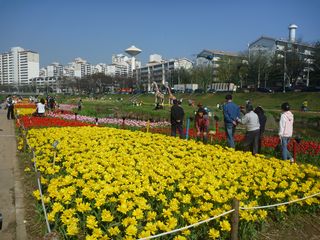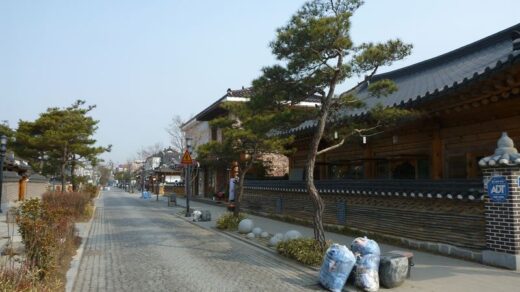I recently sent out the latest edition of my Korean Handbook for Translation Agencies to many of my agency clients.
In "[II] Korean Translation Style Guide" of the Handbook, there's a section on punctuation and spacing. In it, I mention that spacing around parentheses in Korean does not follow the same rules as in English, but I don't attempt to explain it in much detail. Viki Gotz of Echo International emailed me back asking for more information, and so here's an attempt to provide more perspective.
The Use of Spacing Around Periods and Commas
Modern Korean rules for the use of spacing around periods and commas generally follow the English rules. There are exceptions though. For example, when following an English initial with a period, Korean generally does not add a space after the period, nor does it add a period after the last initial:
Ex: U.S.A
This means that when writing English names, Koreans habitually forget to add a space after the initial, even though this is technically wrong:
Ex: Steven S.Bammel
The Use of Spacing Around Parenthesis
In writing Korean, there are many times when English words and phrases (as well as Chinese characters) will appear in the text. This is often done to clarify the meaning of the Korean before it, such as to provide the English source for the Korean translation or transliteration which may not be obvious to the reader without the extra information. This is analogous to providing the full term for an acronym in English the first time it's used in a document:
Ex: North Bay Rehabilitation Services, also known as NBI (North Bay Industries), is an agile company with the ability to accommodate your needs
In English, the parentheses are preceded by a space. However, when inserting English into a Korean sentence like this, there is almost never a space added before the opening parenthesis. In addition, the decision of whether to put a space after the parenthesis depends on the grammatical structure surrounding the word.
In Korean, grammatical particles are often added to the ends of nouns to indicate function in the sentence. So, if a noun which is being modified by the English in parenthesis would normally be followed by an attached particle, then the English is added between the Korean noun and particle without a space added after the parenthesis or before the particle.
Ex: 국가다문화자문위원회(National Multicultural Advisory Council, NMAC)가 1997년에 설립되었습니다.
In the above case, the characters before the parenthesis are the name in Korean of the NMAC. As you can see, the writer even included both the full name and acronym in English within parenthesis together here. But since the NMAC is the subject of the sentence, a grammatical particle must be attached to the subject, so there is no space between it and the closing parenthesis.
To clarify, here's how it would have looked without using the parenthetical English at all:
Ex: 국가다문화자문위원회가 1997년에 설립되었습니다.
However, there are some cases where a particle is not added to a noun and if the Korean noun would normally have been followed by a space, then the closing parenthesis is also followed by a space, even though no space is added before the opening parenthesis:
Ex: 아시아에서 지적재산권(Intellectual Property Rights) 보호에 대한 인식…
In this case, without the English in parenthesis, it would have been like this:
Ex: 아시아에서 지적재산권 보호에 대한 인식…
In fact, sometimes an English word or phrase is inserted directly into a sentence without including the corresponding Korean word and in this case, the English is used without parenthesis and it functions grammatically as a Korean word. Thus, it may or may not be followed by a space and this depends on the Korean grammatical rules:
Ex: American Civil Liberties Union의 한 변호사는… (without a space)
Ex: Schengen 지역을 자유롭게 여행하도록… (with a space)
Unfortunately, there really is not way to know whether a space should be used or not without knowing Korean. But just because the spacing around parenthesis looks inconsistent doesn't mean it's necessarily wrong. I should also point out that when parenthesis are used with pure Korean phrasing, the same rules apply:
Ex: 브랜드 자산은 다양하게 맞춤화된 기준(브랜드 가치를 포함아여)으로 구성된다.
Ex: 소위 '안철수 바람'이 (단일화 논의가 알려진) 어제를 기점으로…
As well, the same rules apply when using English both inside and outside parenthesis:
Ex: SBS(Special Broadcasting Service)와 같은 정부자금으로…
Here are a couple more possible variations on the combination of parenthesis, English, Korean and Chinese characters.
Ex: 이러한 이데올로기는 1850년대 금광열(金鑛熱, Gold Rush)이 지속되는 동안
Ex: 다문화주의는 단순히 "용광로(a melting pot)"를 의미하는 것이 아니다.
In addition, the spacing rules in Korean aren't hard and fast when it comes to the use of parenthesis outside of a sentence. Here's a sentence I came across in a PowerPoint presentation:
Ex: Period: 2001 Jan-Apr (4개월)
It could have just as easily been typed this way and been correct (although it sure does look better to English eyes in the above example):
Ex: Period: 2001 Jan-Apr(4개월)
Finally, a small but useful detail… When the name of a corporation is written in Korean, the "Co. Ltd." part is translated as (주) and put at the beginning of the company name and without a trailing space. Thus, "(주)피죤" would be the Korean for "Pigeon Co., Ltd."
The Use of Spacing Around Quotation Marks
The rules for spacing around quotation marks are also similar to those for parenthesis. Again, it depends on what would have come after the last letter before the closing quotation mark, had the quotation mark not been there.
Ex: 의무성 간부들은 "경악스러운 인사"라며…
I'll point out here that ' and < > are often used in place of quotation marks in Korean and the spacing rules with these also follow the same rules.



